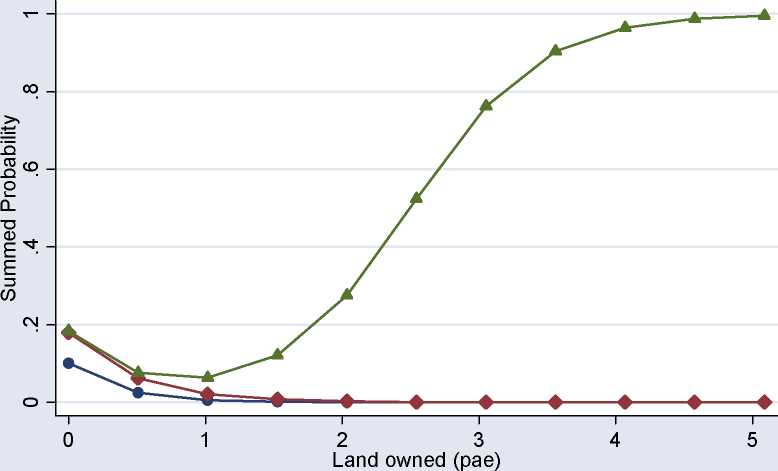Furthermore, results on wealth related assets (land, cattle and physical agricultural capital) are
consistent with non-linear relations found in the separated binomial models above. In
particular, on one hand a marginal increase in the size of land decreases (at an increasing rate)
the probability to migrate either temporary or permanently; on the other hand it increases (at a
declining rate) the probability of household to send a migrant member abroad with respect to
the option of staying put.
Cattle ownership, instead, has a negative effect on the propensity to migrate (at a lowering
rate in case of permanent migration), and agricultural capital endowment does not appear
significant (but mainly with negative signs). This seems to suggest that liquid assets are
substitute investments of migration, as discussed above.
Finally, the incidence of different typologies of migration at village-level, significantly affect
the probability to migrate; interestingly, percentages of permanent or international migrants in
the village negatively affect the probability to migrate only temporary, supporting the
hypothesis of external behaviours influencing household decision to migrate.
In order to show how land ownership affects the probability to migrate either temporary,
nationally or internationally, Figure 2 illustrates the three summed predicted probabilities for
all migration outcomes against the option of staying put.

——■te---temporary ♦ permanent
—a— international
Figure 2: Summed predicted probabilities according to household land-ownership
26
More intriguing information
1. Plasmid-Encoded Multidrug Resistance of Salmonella typhi and some Enteric Bacteria in and around Kolkata, India: A Preliminary Study2. An Economic Analysis of Fresh Fruit and Vegetable Consumption: Implications for Overweight and Obesity among Higher- and Lower-Income Consumers
3. On the Relation between Robust and Bayesian Decision Making
4. The name is absent
5. The geography of collaborative knowledge production: entropy techniques and results for the European Union
6. The Complexity Era in Economics
7. New Evidence on the Puzzles. Results from Agnostic Identification on Monetary Policy and Exchange Rates.
8. Innovation and business performance - a provisional multi-regional analysis
9. La mobilité de la main-d'œuvre en Europe : le rôle des caractéristiques individuelles et de l'hétérogénéité entre pays
10. THE MEXICAN HOG INDUSTRY: MOVING BEYOND 2003